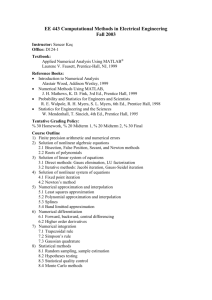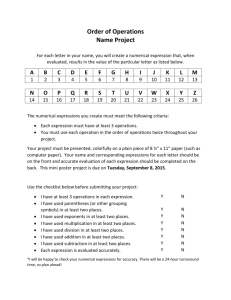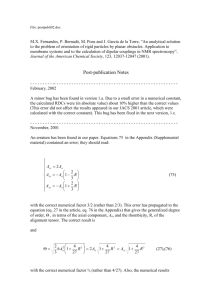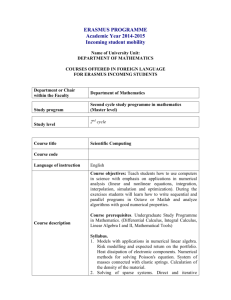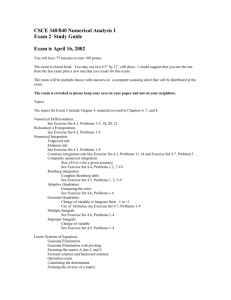EE501:Stochastic Processes
advertisement
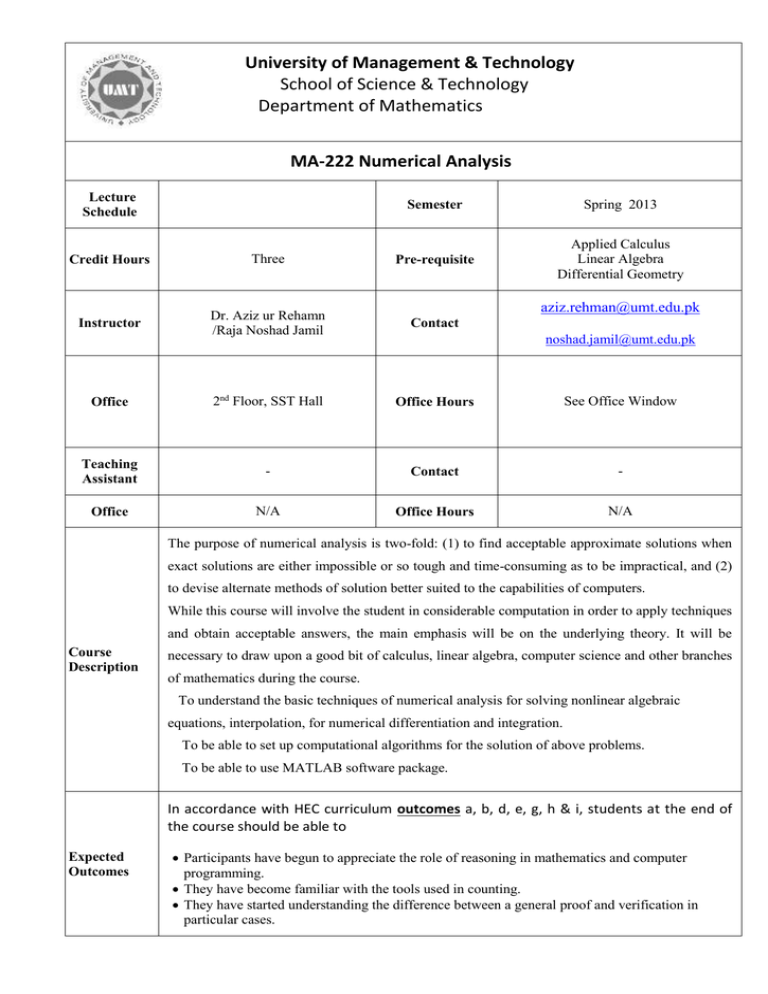
University of Management & Technology School of Science & Technology Department of Mathematics MA-222 Numerical Analysis Lecture Schedule Semester Spring 2013 Applied Calculus Linear Algebra Differential Geometry Credit Hours Three Pre-requisite Instructor Dr. Aziz ur Rehamn /Raja Noshad Jamil Contact Office 2nd Floor, SST Hall Office Hours See Office Window Teaching Assistant - Contact - Office N/A Office Hours N/A aziz.rehman@umt.edu.pk noshad.jamil@umt.edu.pk The purpose of numerical analysis is two-fold: (1) to find acceptable approximate solutions when exact solutions are either impossible or so tough and time-consuming as to be impractical, and (2) to devise alternate methods of solution better suited to the capabilities of computers. While this course will involve the student in considerable computation in order to apply techniques and obtain acceptable answers, the main emphasis will be on the underlying theory. It will be Course Description necessary to draw upon a good bit of calculus, linear algebra, computer science and other branches of mathematics during the course. To understand the basic techniques of numerical analysis for solving nonlinear algebraic equations, interpolation, for numerical differentiation and integration. To be able to set up computational algorithms for the solution of above problems. To be able to use MATLAB software package. In accordance with HEC curriculum outcomes a, b, d, e, g, h & i, students at the end of the course should be able to Expected Outcomes Participants have begun to appreciate the role of reasoning in mathematics and computer programming. They have become familiar with the tools used in counting. They have started understanding the difference between a general proof and verification in particular cases. Text/ Reference books Grading Policy Burden, R.L. and Faires, D.F., Numerical Analysis, 5th ed. PWS-Kent, Boston, MA Steven C. Chapra and Raymond P. Canale, “Numerical Methods for Engineers,” Fifth Edition, 2006, McGraw-Hill, ISBN: 0073101567. Curtis F. Gerald, “Applied Numerical Analysis,” Seventh Edition, 2003, Addison Wesley, ISBN: 0321133048 Saeed Bhatti and Naeem Bhatti :A First Course in Numerical Analysis , Fourth edition, 2003, Shahryar Publishers, Urdu Bazar Lahore.) Computer programming: Quizzes: Midterm: Final: 15% 15% 30% 40% Tentative Schedule Lectures, Reading Assignments, Homework Assignments Wk 1 Chapter 1 1st Lecture Topic to Cover Review of Calculus. What is Numerical Analysis? Why Numerical Techniques? Floating point number systems 2 Various methods of root-finding: graphical and iteration methods. Graphical representation of iteration method. 3 2 The method of false position and secant method. Computational algorithms for these methods. 4 2,6 Error Analysis for Iterative Methods 2 5 7 6 The Jacobi Method, Illustration of the method by examples; Design an algorithm for Jacobi’s method Section 1.1 2.1 2nd Lecture Topic to Cover Definition of error; Relative and Absolute errors. Sources of Errors. Classification of errors: Gross errors, Rounding errors, Truncation errors. Bisection method and its Computational algorithms Section 1.2 2.1 2.2,2.3 The derivation of the NewtonRaphson formula, error in N-R method. Limitations of N-R method. Computational algorithm for N-R method. 2.3 2.4 Linear Systems of Equation, Pivoting Strategies 6.1, 6.2 7.3 Gauss-Seidel method, Illustration of the method by examples; Design an algorithm for GaussSeidel’s method 7.3 Method of least squares Eigen value and Eigen vectors 7 3 Introduction to interpolation. Interpolation using equally-spaced data points. 3.1 Difference table. Detection and correction of errors in difference table. Difference operator. 3.1 8 3 Relationships between Difference operators. 3.2 Interpolation using unequallyspaced data points. 3.2 9 3 Newton’s forward difference, backward difference and central difference interpolation formulas. 3.2 Cubic Spline interpolation. 3.3 10 4 Cubic Spline interpolation. 3.3 Introduction to Numerical Differentiation 4.1 11 4 Approximation of derivatives using Newton’s forward, backward and central difference formulas. 4.3 Introduction to numerical integration, Trapezoidal Rule and its Algorithms. 4.3 12 4 Simpson’s 1/3 method with algorithm. 4.3 Simpson’s 3/8 method with algorithm 4.3 13 4 Exercises on Numerical differentiation and integration 4.1, 4.2 Exercises on Numerical differentiation and integration 4.3,4.4 14 4 Numerical solution ordinary Differential Equations 4.1, 4.2 Numerical solution ordinary Differential Equations 4.3,4.4 Numerical solution partial Differential Equations 15 Numerical solution partial Differential Equations Revision
